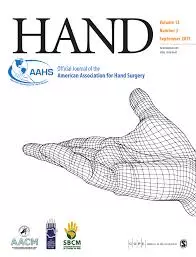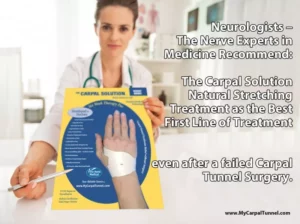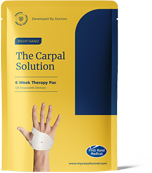

Problems After Carpal Tunnel Surgery
 I am having the same problems with Carpal Tunnel Symptoms post-surgery as I had before Carpal Tunnel Surgery. The surgeon wants to do another surgery to fix it, but I am done with surgical solutions for Carpal Tunnel. My Carpal Tunnel Symptoms actually seem worse after surgery than they were before. What treatment can I do now to put the horrible numbness, lingering hand pain, achy wrist, shooting pain, burning palms and forearm pain – behind me once and for all? As for a “Second Surgery for Carpal Tunnel”? That is not happening!
I am having the same problems with Carpal Tunnel Symptoms post-surgery as I had before Carpal Tunnel Surgery. The surgeon wants to do another surgery to fix it, but I am done with surgical solutions for Carpal Tunnel. My Carpal Tunnel Symptoms actually seem worse after surgery than they were before. What treatment can I do now to put the horrible numbness, lingering hand pain, achy wrist, shooting pain, burning palms and forearm pain – behind me once and for all? As for a “Second Surgery for Carpal Tunnel”? That is not happening!
Shannon
Schaumberg, Illinois
Answers from Doctors at First Hand Medical:
Sorry to hear of your issues post-Carpal Tunnel Surgery. The truth is many people experience what you are describing after a Carpal Tunnel Surgical Procedure. Some patients get worse after the Carpal Tunnel Operation.
In clinical studies, it has been reported that as high as 40% to 45% of patients report continuing symptoms of Carpal Tunnel Syndrome after the operation. About 8% of patients report that their symptoms are worse after the procedure.
Even when Carpal Tunnel Surgery is deemed a success by patients, it comes back within 1 to 10 years for over 90% of patients.
Most patients would never submit willingly to this type of surgical prognosis. It just does not make sense. The prognosis for second carpal tunnel surgical procedures is even worse. 60 – 70% of patients report problems with a second Carpal Tunnel Operation.
The high failure rate for “Revision Carpal Tunnel Surgery” is due to the accumulation of scar tissue from the first surgery.
Once, scar tissue has healed back over a wound and then it is disturbed by revision surgery, it never heals back quite the same.
Scar Tissue does not have the memory of the original tissue.
Second Revision Surgery is sketchy enough with less than a 40% success rate. Scar Tissue complications is why “Third Surgical Procedures for Carpal Tunnel” are strongly discouraged by orthopedic extremity experts.

 In Plastic Reconstructive Surgery – The Journal of the American Society of Plastic Surgeons,
In Plastic Reconstructive Surgery – The Journal of the American Society of Plastic Surgeons,
By: NF Jones, MD Professor of Orthopedic Surgery and Director of UC Irvine Hand Center published the following information about Revision Surgery for Carpal Tunnel Release.
BACKGROUND: Carpal tunnel release is one of the most frequently performed hand operations. However, persistent, recurrent, or completely new symptoms following carpal tunnel release remain a difficult problem.
METHODS: A retrospective review of the surgical findings and outcomes of 50 consecutive patients who had undergone 55 revision carpal tunnel operations was performed.
 RESULTS:
RESULTS:
The initial carpal tunnel release was an endoscopic technique in 34 hands and an open technique in 21 hands.
Thirty-four hands continued to have persistent symptoms, 18 hands had recurrent symptoms, and three hands had completely new symptoms generated from the original release surgical procedure.
Surgical re-exploration revealed incomplete release of the transverse carpal ligament in 32 patients.
Circumferential fibrosis around the median nerve was found in all patients.
Forty-six percent of patients with recurrent symptoms had slight palmar subluxation of the median nerve.
External neurolysis was performed in 41, epineurectomy was performed in 15, synovial or hypothenar fat flap coverage was performed in eight, and radial forearm adipofascial flap coverage was performed in three hands.
Some symptomatic improvement following revision surgery was achieved after open carpal tunnel release was slightly better (90 percent) compared with after endoscopic carpal tunnel release (76 percent).
Complete relief of symptoms following revision surgery was similar after open (57 percent) or endoscopic (56 percent) techniques.
(In other words less than 57% reported complete relief after the revision surgery)
Ten patients (20 percent) showed no improvement after the revision surgery.
Five patients (10 percent) required a third operation because symptoms worsened sufficiently to justify a third surgical procedure.
 CONCLUSIONS: Patients have issues following Carpal Tunnel Release Surgery due to several factors:
CONCLUSIONS: Patients have issues following Carpal Tunnel Release Surgery due to several factors:
(1) They continue to have persistent symptoms after carpal tunnel release because of incorrect diagnosis or incomplete release of the transverse carpal ligament;
(2) They develop recurrent symptoms caused by circumferential fibrosis; (the thickening and scarring of connective tissue around the median nerve, usually as a result of original release surgery. It is common for this scarring of connective tissue to limit free movement without discomfort or pain.) or
(3) (The patient develop completely) new symptoms, which usually implies iatrogenic injury (adverse effects that happen with invasive procedures like carpal tunnel release surgery) to branches of the median nerve (that happened due to complications arising from the first surgical release procedure).
https://www.ncbi.nlm.nih.gov/pubmed/22090245 Plastic and Reconstructive Surgery
https://meeting.handsurgery.org/abstracts/2012/22.cgi American Association of Hand Surgeons
Parenthetical interpretation is added for clarity and to aid to a laymen more readily understanding the surgeons technical jargon.

 To learn more about the Risks and Complications of Carpal Tunnel Release Surgery Click Here: https://www.mycarpaltunnel.com/carpal-tunnel-surgery/complications-and-risks.shtml
To learn more about the Risks and Complications of Carpal Tunnel Release Surgery Click Here: https://www.mycarpaltunnel.com/carpal-tunnel-surgery/complications-and-risks.shtml
So, what Treatment can be done now to avoid further complications and scar tissue from “Revision Carpal Tunnel Surgery”?
You have to wait for at least 2 to 3 months after a Carpal Tunnel Release Operation before you can begin the Carpal Solution Nighttime Stretching Treatment.
Learn More about Natural Stretching Treatment Developed by Doctors that works for 97% of people.
Additional Steps that will help you recover from the effects of a Failed Carpal Tunnel Surgery.
- Follow First Hand Medical’s Hand/Wrist/Forearm 20 minute Icing Protocol (up to 3 times per day)
- Dry Needling Therapy by a Physical Therapist – combining the best of acupuncture and interferential current therapy. (3 times per week for 1st month).
- Deep Tissue Massage at home with bouncy balls or by a professional masseuse (3 to 7 times per week)
- Daytime Stretching Exercises (Daily)
- Stay Hydrated – (Drink lots of water daily)
- Follow First Hand Medical’s Low Carb / Low Sugar Diet to reduce inflammation – Inflammation is the driver behind all chronic diseases commonly afflicting people eating a high carb western diet. Inflammation also drives Carpal Tunnel Syndrome. Trapped inflammation and Lymphatic Fluid is the main cause of Carpal. (Daily)
- Take Multi-Collagen up to 3 times per day for first month
- Therapy Putty https://www.verywellhealth.com/exercises-you-can-do-with-therapy-putty-2696612
- Avoid Grip Strength Exercises until you are fully recovered – normal hand use is enough to regenerate muscles in the beginning
- Avoid Yoga Poses that put pressure on your wrist

Contact First Hand Medical for guidance on all of these steps. We can provide “Keto Tools” you need to easily go low carb without the side effects. We also offer the best quality Collagen Supplements at the best pricing you will find anywhere. Lowering your Carb and Sugar intake will not only benefit Carpal Tunnel healing, but will lead to a much healthier body for life.
We can help you.
 Created by renowned Harvard health care professionals.
Created by renowned Harvard health care professionals. 



